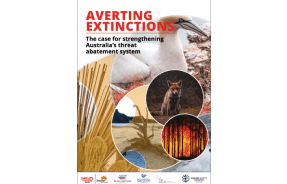This report by five national conservation groups warns that Australia faces an avalanche of imminent extinctions unless the threat abatement system is strengthened.
This document identifies the problems with Australia’s threat abatement system and recommends reforms. These need to be coupled with reforms to improve recovery planning and implementation, but they are not the focus in this report. The proposed threat abatement reforms have been developed in collaboration with ecologists, policy experts and environmental NGOs, and incorporate planning recommendations from the independent review of the EPBC Act in 2020 and are presented as 3 major tasks:
- Task 1: Strengthen the threat abatement system – focused on improving the statutory processes to list threats and apply effective threat abatement responses.
- Task 2: Secure adequate funding for threat abatement – focused on defining the level of funding needed for effective threat abatement, the economic benefits of abatement and the potential sources of funding.
- Task 3: Inspire a strong national commitment to threat abatement – focused on intergovernmental commitments, nationally coordinated and collaborative threat abatement, community participation and independent oversight of progress.
A threat abatement plan outlines the research, management and other actions needed to reduce the impacts of a key threatening process. It can work well for some threats, particularly those requiring on-ground responses. The abatement plan for feral cats, for example, is driving the development of more effective control techniques, research on interactions with fire and grazing, and improved management. A few other threats are the focus of threat abatement advices (government guidance about abatement measures) and action plans (focused on both environmental and non-environmental impacts), neither of which have a statutory basis.
But other threats need different remedies: land clearing, for example, requires policy and regulatory responses and restoration programs, and climate change requires adaptation strategies and protection of refugia (in addition to mitigation measures, which are managed outside the threat abatement system).




